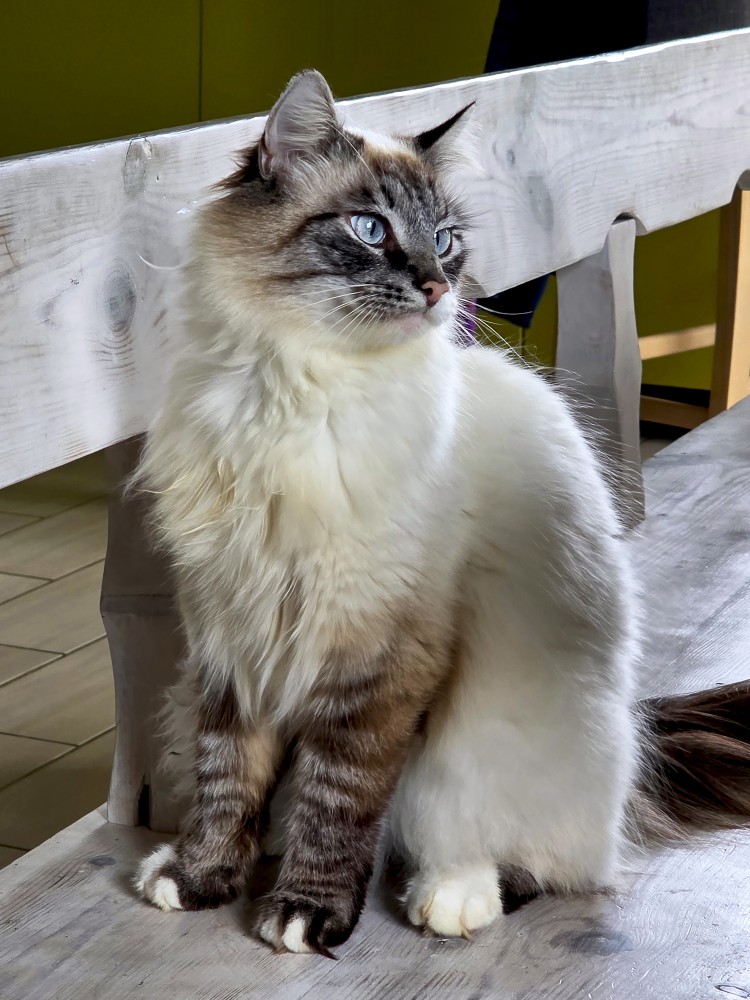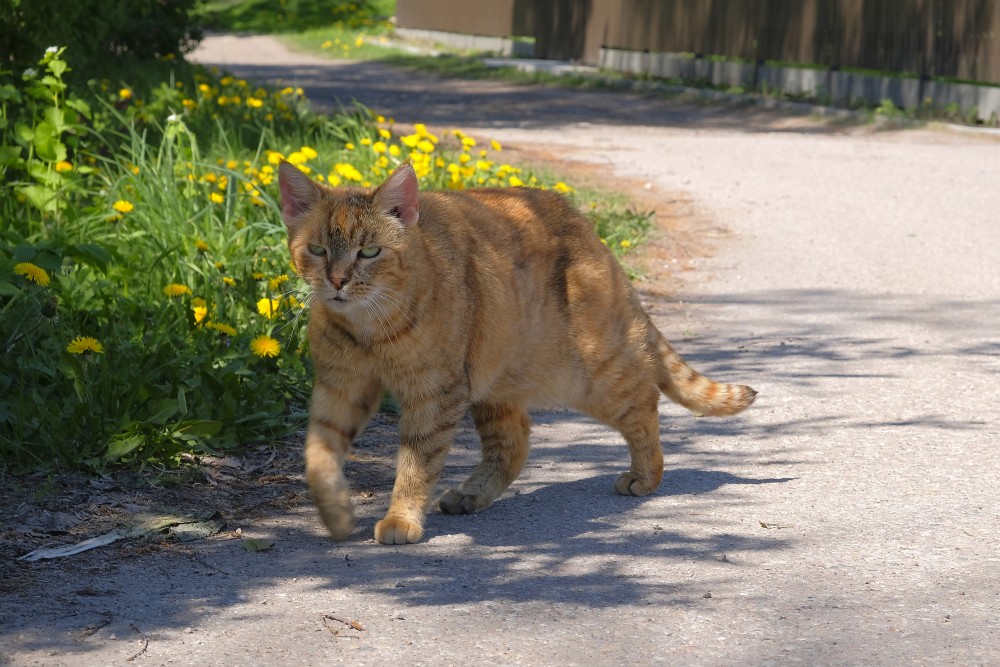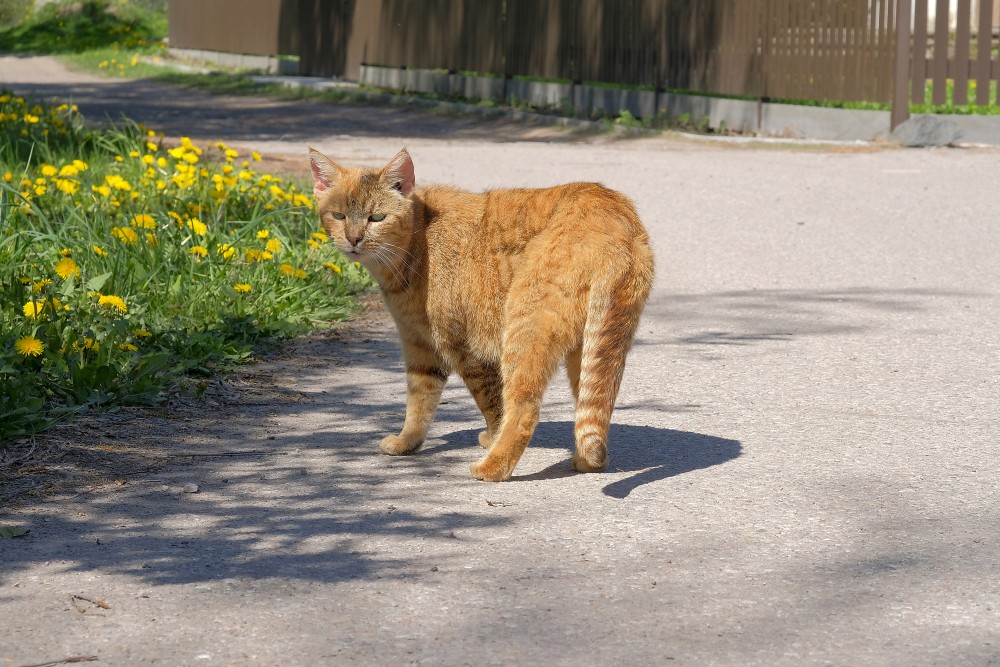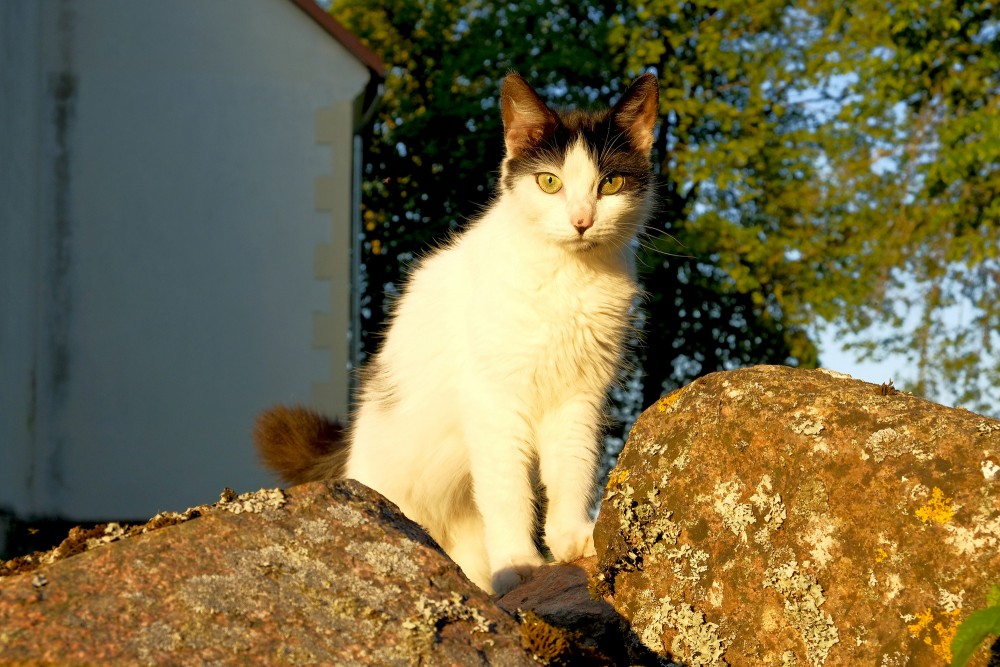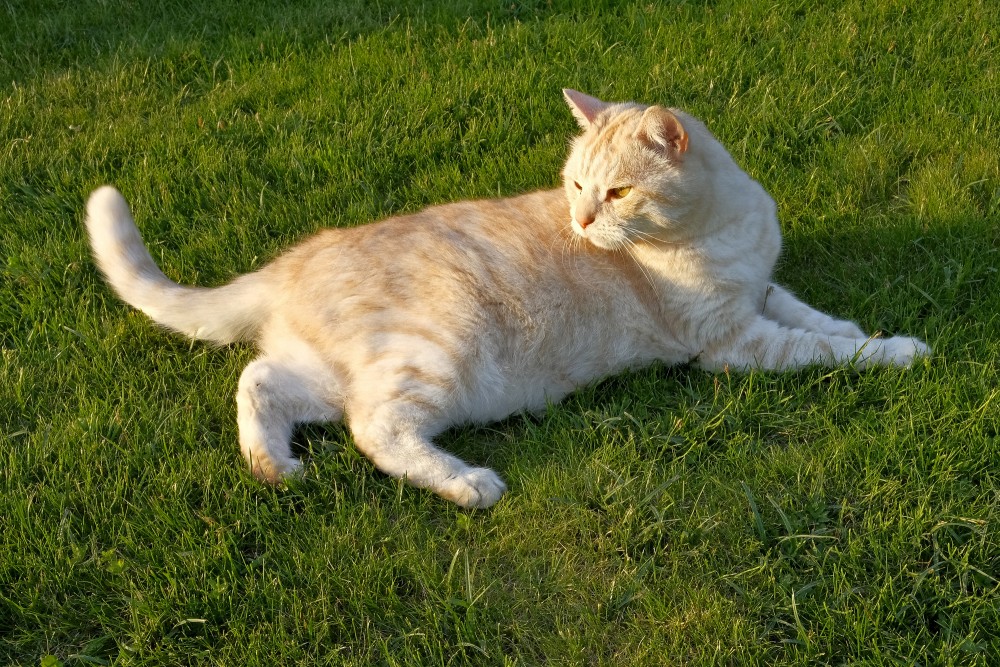Cat
Biology
Anatomy
Domestic cats are similar in size to the other members of the genus Felis, typically weighing between 4 and 5 kg (9 and 10 lb). Some breeds, such as the Maine Coon, can occasionally exceed 11 kg (24 lb). Conversely, very small cats, less than 2 kg (4 lb), have been reported. The world record for the largest cat is 21 kg (50 lb). The smallest adult cat ever officially recorded weighed around 1 kg (2 lb). Feral cats tend to be lighter, as they have more limited access to food than house cats. The Boston Cat Hospital weighted trapped feral cats, and found the average feral adult male to weigh 4 kg (9 lb), and average adul female 3 kg (7 lb). Cats average about 23–25 cm (9–10 in) in height and 46 cm (18 in) in head/body length (males being larger than females), with tails averaging 30 cm (12 in) in length; feral cats may be smaller on average.
Cats have seven cervical vertebrae, as do almost all mammals; 13 thoracic vertebrae (humans have 12); seven lumbar vertebrae (humans have five); three sacral vertebrae like most mammals (humans have five); and a variable number of caudal vertebrae in the tail (humans have only vestigial caudal vertebrae, fused into an internal coccyx). The extra lumbar and thoracic vertebrae account for the cat's spinal mobility and flexibility. Attached to the spine are 13 ribs, the shoulder, and the pelvis. Unlike human arms, cat forelimbs are attached to the shoulder by free-floating clavicle bones which allow them to pass their body through any space into which they can fit their head.
The cat skull is unusual among mammals in having very large eye sockets and a powerful and specialized jaw. Within the jaw, cats have teeth adapted for killing prey and tearing meat. When it overpowers its prey, a cat delivers a lethal neck bite with its two long canine teeth, inserting them between two of the prey's vertebrae and severing its spinal cord, causing irreversible paralysis and death. Compared to other felines, domestic cats have narrowly spaced canine teeth, which is an adaptation to their preferred prey of small rodents, which have small vertebrae. The premolar and first molar together compose the carnassial pair on each side of the mouth, which efficiently shears meat into small pieces, like a pair of scissors. These are vital in feeding, since cats' small molars cannot chew food effectively, and cats are largely incapable of mastication. Although cats tend to have better teeth than most humans, with decay generally less likely because of a thicker protective layer of enamel, a less damaging saliva, less retention of food particles between teeth, and a diet mostly devoid of sugar, they are nonetheless subject to occasional tooth loss and infection.
Cats, like dogs, are digitigrades. They walk directly on their toes, with the bones of their feet making up the lower part of the visible leg. Cats are capable of walking very precisely because, like all felines, they directly register; that is, they place each hind paw (almost) directly in the print of the corresponding fore paw, minimizing noise and visible tracks. This also provides sure footing for their hind paws when they navigate rough terrain. Unlike most mammals, when cats walk, they use a "pacing" gait; that is, they move the two legs on one side of the body before the legs on the other side. This trait is shared with camels and giraffes. As a walk speeds up into a trot, a cat's gait changes to be a "diagonal" gait, similar to that of most other mammals (and many other land animals, such as lizards): the diagonally opposite hind and fore legs move simultaneously.
Like almost all members of the Felidae, cats have protractable and retractable claws. In their normal, relaxed position, the claws are sheathed with the skin and fur around the paw's toe pads. This keeps the claws sharp by preventing wear from contact with the ground and allows the silent stalking of prey. The claws on the fore feet are typically sharper than those on the hind feet. Cats can voluntarily extend their claws on one or more paws. They may extend their claws in hunting or self-defense, climbing, kneading, or for extra traction on soft surfaces. Most cats have five claws on their front paws, and four on their rear paws. The fifth front claw (the dewclaw) is proximal to the other claws. More proximally is a protrusion which appears to be a sixth "finger". This special feature of the front paws, on the inside of the wrists, is the carpal pad, also found on the paws of big cats and dogs. It has no function in normal walking, but is thought to be an antiskidding device used while jumping. Some breeds of cats are prone to polydactyly (extra toes and claws). These are particularly common along the northeast coast of North America.
Physiology
Cats are familiar and easily kept animals, and their physiology has been particularly well studied; it generally resembles those of other carnivorous mammals, but displays several unusual features probably attributable to cats' descent from desert-dwelling species. For instance, cats are able to tolerate quite high temperatures: Humans generally start to feel uncomfortable when their skin temperature passes about 38 °C (100 °F), but cats show no discomfort until their skin reaches around 52 °C (126 °F), and can tolerate temperatures of up to 56 °C (133 °F) if they have access to water.
Body temperature 38.6 °C (101.5 °F)
Heart rate 120–140 beats per minute
Breathing rate 16–40 breaths per minute
Cats conserve heat by reducing the flow of blood to their skin and lose heat by evaporation through their mouths. Cats have minimal ability to sweat, with glands located primarily in their paw pads, and pant for heat relief only at very high temperatures (but may also pant when stressed). A cat's body temperature does not vary throughout the day; this is part of cats' general lack of circadian rhythms and may reflect their tendency to be active both during the day and at night. Cats' feces are comparatively dry and their urine is highly concentrated, both of which are adaptations to allow cats to retain as much water as possible. Their kidneys are so efficient, they can survive on a diet consisting only of meat, with no additional water,[80] and can even rehydrate by drinking seawater. While domestic cats are able to swim, they are generally reluctant to enter water as it quickly leads to exhaustion.
Nutrition
Cats are obligate carnivores: their physiology has evolved to efficiently process meat, and they have difficulty digesting plant matter. In contrast to omnivores such as rats, which only require about 4% protein in their diet, about 20% of a cat's diet must be protein. A cat's gastrointestinal tract is adapted to meat eating, being much shorter than that of omnivores and having low levels of several of the digestive enzymes needed to digest carbohydrates. These traits severely limit the cat's ability to digest and use plant-derived nutrients, as well as certain fatty acids. Despite the cat's meat-oriented physiology, several vegetarian or vegan cat foods have been marketed that are supplemented with chemically synthesized taurine and other nutrients, in attempts to produce a complete diet. However, some of these products still fail to provide all the nutrients cats require, and diets containing no animal products pose the risk of causing severe nutritional deficiencies. However, veterinarians in the United States have expressed concern that many domestic cats are overfed.
Cats do eat grass occasionally. A proposed explanation is that cats use grass as a source of folic acid. Another is that it is used to supply dietary fiber, helping the cat defecate more easily and expel parasites and other harmful material through feces and vomit.
Cats are unusually dependent on a constant supply of the amino acid arginine, and a diet lacking arginine causes marked weight loss and can be rapidly fatal. Arginine is an essential additive in cat food because cats have low levels of the enzymes aminotransferase and pyrroline-5-carboxylate which are responsible for the synthesis of ornithine and citrulline in the small intestine. Citrulline would typically go on to the kidneys to make arginine, but because cats have a deficiency in the enzymes that make it, citrulline is not produced in adequate quantities to make arginine. Arginine is essential in the urea cycle in order to convert the toxic component ammonia into urea that can then be excreted in the urine. Because of its essential role, deficiency in arginine results in a build up of toxic ammonia and leads to hyperammonemia.[89] The symptoms of hyperammonemia include lethargy, vomiting, ataxia, hyperesthesia and can be serious enough to induce death and coma in a matter of days if a cat is being fed an arginine-free diet. The quick onset of these symptoms is due to the fact that diets devoid in arginine will typically still contain all of the other amino acids, which will continue to be catabolized by the body, producing mass amounts of ammonia that very quickly build up with no way of being excreted.
Another unusual feature is that the cat cannot produce taurine,[note 1] with a deficiency in this nutrient causing macular degeneration, wherein the cat's retina slowly breaks down, causing irreversible blindness. This is due to the hepatic activity of cystinesulfinic acid decarboxylase being low in cats. This limits the ability of cats to biosynthesize the taurine they need from its precursor, the amino acid cysteine, which ultimately results in inadequate taurine production needed for normal function. Deficiencies in taurine result in compensated function of feline cardiovascular and reproductive systems. These abnormalities can also be accompanied by developmental issues in the central nervous system along with degeneration of the retina.
In order to produce the essential vitamin niacin for use in the cat, tryptophan is needed for conversion purposes. However, due to a competing pathway with acetyl coenzyme A (acetyl-CoA), niacin can become deficient and require supplementation. This process occurs when an overactive enzyme, picolinic acid carboxylase, converts the vitamin B6 precursor picolinic acid into the alternate compound acetyl-CoA, instead of converting quinolinate into nictotinic acid mononlucleotide (niacin). Niacin is required in cats as it supports enzyme function. If niacin is deficient in the diet, anorexia, weight loss and an increase in body temperature can result.
Preformed vitamin A is required in the cat for retinal and reproductive health. Vitamin A is considered to be a fat-soluble vitamin and is seen as essential in a cat's diet. Normally, the conversion of beta-carotenes into vitamin A occurs in the intestine (more specifically the mucosal layer) of species, however cats lack the ability to undergo this process. Both the kidney and liver are contributors to the use of vitamin A in the body of the majority of species while the cats liver does not produce the enzyme Beta-carotene 15,15'-monooxygenase which converts the beta-carotene into retinol (vitamin A). To summarize: cats do not have high levels of this enzyme leading to the cleavage and oxidation of carotenoids not taking place.
Vitamin D3 is a dietary requirement for cats as they lack the ability to synthesize vitamin D3 from sunlight. Cats obtain high levels of the enzyme 7-dehydrocholestrol delta 7 reductase which causes immediate conversion of vitamin D3 from sunlight to 7-dehydrocholesterol. This fat soluble vitamin is required in cats for bone formation through the promotion of calcium retention, along with nerve and muscle control through absorption of calcium and phosphorus.
Cats, like all mammals, need to get linoleic acid, an essential fatty acid, from their diet. Most mammals can convert linoleic acid to arachidonic acid, as well as the omega 3 fatty acids (eicosapentaenoic acid and docosahexaenoic acid) through the activity of enzymes, but this process is very limited in cats. The Δ6-desaturase enzyme eventually converts linoleic acid, which is in its salt form linoleate, to arachidonate (salt form of arachidonic acid) in the liver, but this enzyme has very little activity in cats. This means that arachidonic acid is an essential fatty acid for cats as they lack the ability to create required amounts of linoleic acid. Deficiency of arachidonic acid in cats is related to problems in growth, can cause injury and inflammation to skin (e.g. around the mouth) decreased platelet aggregation, fatty liver, increase in birth defects of kittens whose queens were deficient during pregnancy, and reproductive failure in queens.[92] Arachidonic acid can also be metabolized to eicosanoids that create inflammatory responses which are needed to stimulate proper growth and repair mechanisms in the cat.
Cat food § Nutrient chart provides a list of the many nutrients cats require as well as the use of the nutrients in the body and the effects of the deficiency.
Senses
Cats have excellent night vision and can see at only one-sixth the light level required for human vision. This is partly the result of cat eyes having a tapetum lucidum, which reflects any light that passes through the retina back into the eye, thereby increasing the eye's sensitivity to dim light.[99] Another adaptation to dim light is the large pupils of cats' eyes. Unlike some big cats, such as tigers, domestic cats have slit pupils. These slit pupils can focus bright light without chromatic aberration, and are needed since the domestic cat's pupils are much larger, relative to their eyes, than the pupils of the big cats. At low light levels, a cat's pupils will expand to cover most of the exposed surface of its eyes. However, domestic cats have rather poor color vision and (like most nonprimate mammals) have only two types of cones, optimized for sensitivity to blue and yellowish green; they have limited ability to distinguish between red and green. A 1993 paper reported a response to middle wavelengths from a system other than the rods which might be due to a third type of cone. However, this appears to be an adaptation to low light levels rather than representing true trichromatic vision.
Cats have excellent hearing and can detect an extremely broad range of frequencies. They can hear higher-pitched sounds than either dogs or humans, detecting frequencies from 55 Hz to 79,000 Hz, a range of 10.5 octaves, while humans and dogs both have ranges of about 9 octaves. Cats can hear ultrasound, which is important in hunting because many species of rodents make ultrasonic calls. However, they do not communicate using ultrasound like rodents do. Cats' hearing is also sensitive and among the best of any mammal, being most acute in the range of 500 Hz to 32 kHz. This sensitivity is further enhanced by the cat's large movable outer ears (their pinnae), which both amplify sounds and help detect the direction of a noise.
Cats have an acute sense of smell, due in part to their well-developed olfactory bulb and a large surface of olfactory mucosa, about 5.8 cm2 (0.90 in2) in area, which is about twice that of humans. Cats are sensitive to pheromones such as 3-mercapto-3-methylbutan-1-ol, which they use to communicate through urine spraying and marking with scent glands. Many cats also respond strongly to plants that contain nepetalactone, especially catnip, as they can detect that substance at less than one part per billion. About 70–80% of cats are affected by nepetalactone. This response is also produced by other plants, such as silver vine (Actinidia polygama) and the herb valerian; it may be caused by the smell of these plants mimicking a pheromone and stimulating cats' social or sexual behaviors.
Cats have relatively few taste buds compared to humans (470 or so versus more than 9,000 on the human tongue). Domestic and wild cats share a gene mutation that keeps their sweet taste buds from binding to sugary molecules, leaving them with no ability to taste sweetness. Their taste buds instead respond to acids, amino acids like protein, and bitter tastes. Cats and many other animals have a Jacobson's organ in their mouths that is used in the behavioral process of flehmening. It allows them to sense certain aromas in a way that humans cannot. Cats also have a distinct temperature preference for their food, preferring food with a temperature around 38 °C (100 °F) which is similar to that of a fresh kill and routinely rejecting food presented cold or refrigerated (which would signal to the cat that the "prey" item is long dead and therefore possibly toxic or decomposing).
To aid with navigation and sensation, cats have dozens of movable whiskers (vibrissae) over their body, especially their faces. These provide information on the width of gaps and on the location of objects in the dark, both by touching objects directly and by sensing air currents; they also trigger protective blink reflexes to protect the eyes from damage.
Most breeds of cat have a noted fondness for settling in high places, or perching. In the wild, a higher place may serve as a concealed site from which to hunt; domestic cats may strike prey by pouncing from a perch such as a tree branch, as does a leopard. Another possible explanation is that height gives the cat a better observation point, allowing it to survey its territory. During a fall from a high place, a cat can reflexively twist its body and right itself using its acute sense of balance and flexibility. This is known as the cat righting reflex. An individual cat always rights itself in the same way, provided it has the time to do so, during a fall. The height required for this to occur is around 90 cm (3.0 ft). Cats without a tail (e.g. many specimens of the Manx and Cymric breeds) also have this ability, since a cat mostly relies on leg movement and conservation of angular momentum to set up for landing, and the tail is little used for this feat. Their excellent sense of balance allows cats to move with great stability. A cat falling from heights of up to 3 meters can right itself and land on its paws.
Health
The average lifespan of pet cats has risen in recent years. In the early 1980s, it was about seven years, rising to 9.4 years in 1995 and 15 years today. However, cats have been reported as surviving into their 30s, with the oldest known cat, Creme Puff, dying at a verified age of 38.
Spaying or neutering increases life expectancy: one study found neutered male cats live twice as long as intact males, while spayed female cats live 62% longer than intact females. Having a cat neutered confers health benefits, because castrated males cannot develop testicular cancer, spayed females cannot develop uterine or ovarian cancer, and both have a reduced risk of mammary cancer.
en.wikipedia.org
https://en.wikipedia.org/wiki/Cat
Continue reading